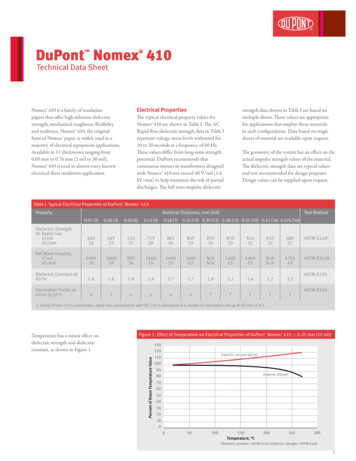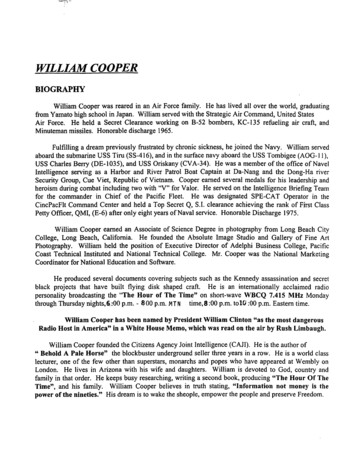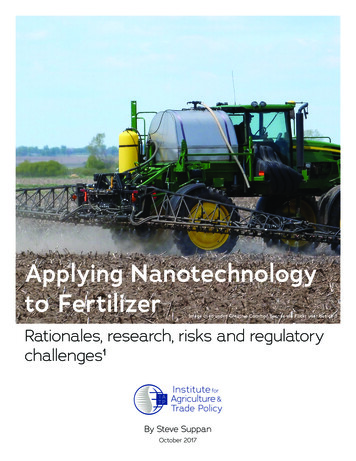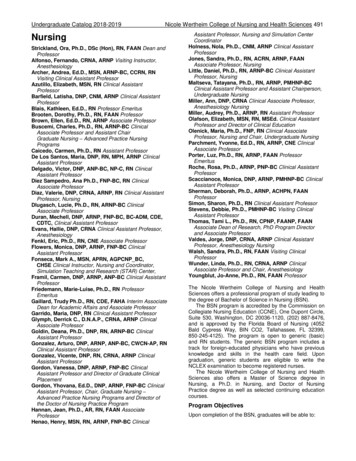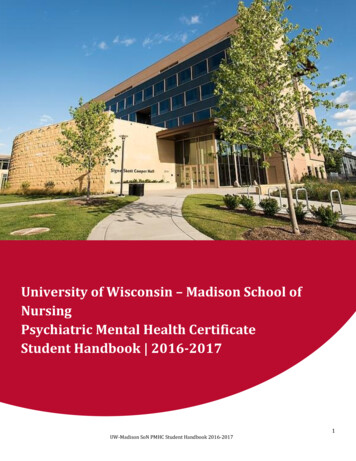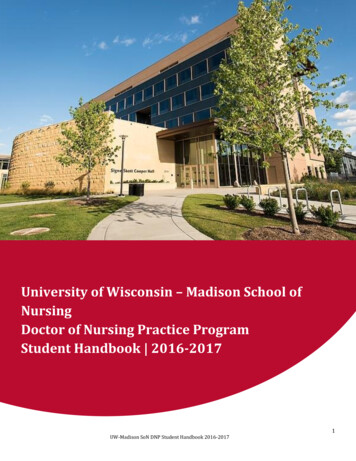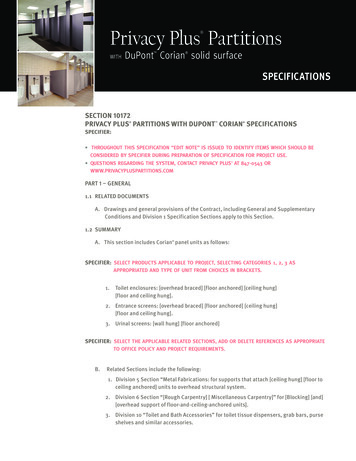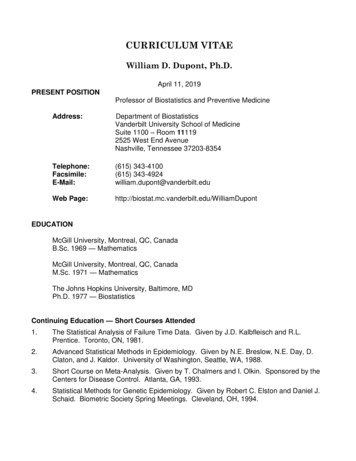
Transcription
CURRICULUM VITAEWilliam D. Dupont, Ph.D.April 11, 2019PRESENT POSITIONProfessor of Biostatistics and Preventive MedicineAddress:Department of BiostatisticsVanderbilt University School of MedicineSuite 1100 – Room 111192525 West End AvenueNashville, Tennessee 37203-8354Telephone:Facsimile:E-Mail:(615) 343-4100(615) 343-4924william.dupont@vanderbilt.eduWeb tEDUCATIONMcGill University, Montreal, QC, CanadaB.Sc. 1969 — MathematicsMcGill University, Montreal, QC, CanadaM.Sc. 1971 — MathematicsThe Johns Hopkins University, Baltimore, MDPh.D. 1977 — BiostatisticsContinuing Education — Short Courses Attended1.The Statistical Analysis of Failure Time Data. Given by J.D. Kalbfleisch and R.L.Prentice. Toronto, ON, 1981.2.Advanced Statistical Methods in Epidemiology. Given by N.E. Breslow, N.E. Day, D.Claton, and J. Kaldor. University of Washington, Seattle, WA, 1988.3.Short Course on Meta-Analysis. Given by T. Chalmers and I. Olkin. Sponsored by theCenters for Disease Control. Atlanta, GA, 1993.4.Statistical Methods for Genetic Epidemiology. Given by Robert C. Elston and Daniel J.Schaid. Biometric Society Spring Meetings. Cleveland, OH, 1994.
Dupont – 25.Visualizing Data with Trellis Graphics. Given by Stephen Kaluzny. The InternationalBiometric Society (ENAR) Meeting. Memphis, TN, March, 1997.6.Writing Mixed models and SAS PROC MIXED for Repeated Measures and RandomEffects Data. Given by R. D. Wolfinger. The International Biometric Society (ENAR)Meeting. Memphis, TN, 1997.7.Statistical Analysis with Missing Data. Given by R.J.A. Little and T.E. Raghunathan. TheInternational Biometric Society (ENAR) Meeting. Pittsburgh, PA, 2004.8.Modeling and Analysis of Categorical Data with Overdispersion. Given by Jorge Moreland Nagaraj Neerchal. Joint Statistical Meetings. Toronto, Ontario Canada. 2004.9.Power and Sample Size Analysis Using New SAS/STAT Software. Given by JohnCastelloe. Joint Statistical Meetings. Toronto, Ontario Canada. 2004.10.Statistical Genetics. Given by Kenneth Lange, Janet Sinsheimer and Eric Sobel. JointStatistical Meetings. Salt Lake City, Utah. 2007.11.Absolute Risk Prediction. Given by Mitchell H. Gail and Ruth Pfeiffer, Joint StatisticalMeetings. Washington, DC. 2009.12.Multilevel and Mixed Models in Stata. Given by Roberto G. Gutierrez. Joint StatisticalMeetings. Washington, DC. 2009.13.Causal Inference. Given by Miguel Hernan and James Robins. Joint StatisticalMeetings. Vancouver, BC, Canada. 2010.14.Statistical Methods for Genome-wide Association Studies. Given by Jennifer Clarke andAdrian Dobra. Joint Statistical Meetings. Vancouver, BC, Canada. 2010.15.Sensitivity Analysis with Missing Data: Statistical Methods and Case Studies. Given byJoseph Hogan and Daniel Scharfstein. ENAR spring meetings. Washington, DC. 2012.16.Statistical Genetic and Genomic Analysis of Complex Traits with GWAS and NextGeneration Sequencing Data. Given by Hongyu Zhao and Fei Zou. ENAR springmeetings. Austin TX, 2016.17.Interactive Data Visualizations in R with shiny and ggplot2. Given by Garrett Grolemund.ENAR spring meetings. Austin TX, 2016.18.A New Paradigm for Finding the Subset of Patients who Benefit from a Test Treatment.Given by Richard Simon and Noah Simon. ENAR spring meetings. Austin TX, 2016.19.Quantile Regression for Survival Analysis. Given by Limin Peng. ENAR spring meetings.Austin TX, 2016.20.Machine Learning, Artificial Intelligence, and Precision Medicine. Given by Haoda Fu &Yufeng Liu. ENAR spring meetings. Washington DC, 2017.21.Statistical Evaluation of Medical Risk Prediction Models in the Presence of CompetingRisks. Given by Michael W. Kattan & Thomas A. Gerds. ENAR spring meetings.Washington DC, 2017.22.Statistical Analysis of RNA Sequencing Data. Given by Mingyao Li. ENAR springmeetings. Washington DC, 2017.
Dupont – 323.Data-driven Modeling Techniques for Medical Decision Making. Given by MadhuMazumdar. ENAR spring meetings. Washington DC, 2017.24.Statistical Issues in Comparative Effectiveness Research. Given by Sharon-LiseNormand. ENAR spring meetings. Washington DC, 2017.ACADEMIC APPOINTMENTS1976 – 1977LecturerUniversity of Maryland in Baltimore County1977 – 1985Assistant Professor of Preventive Medicine(Biostatistics)Vanderbilt University School of Medicine1986 – 1992Associate Professor of Preventive Medicine(Biostatistics with tenure)Vanderbilt University School of Medicine1987 – 1988Acting Director, Division of BiostatisticsVanderbilt University School of Medicine1989 – 2003Director, Division of BiostatisticsVanderbilt University School of Medicine1992 – presentProfessor of Preventive Medicine (Biostatistics)Vanderbilt University School of Medicine1994 – 1997Director, Biostatistics/Data Management Shared ResourceVanderbilt Cancer CenterVanderbilt University School of Medicine2003 – presentProfessor of BiostatisticsVanderbilt University School of Medicine2010 – 2019Vice-Chair for Academic Affairs, Department of BiostatisticsVanderbilt University School of MedicinePROFESSIONAL ORGANIZATIONS1.2.3.4.5.American Statistical Association, 1975 – presentBiometric Society, 1974 – presentSociety for Clinical Trials, 1980 – ?Society for Epidemiologic Research, 1985 – 1994American Association for the Advancement of Science, 1987 – 2003
Dupont – 4PROFESSIONAL ACTIVITIESIntramural1. Member of the Graduate Faculty Delegate Assembly at Vanderbilt University, 1979 –1982.2. Member of the Clinical Research Center Advisory Committee, 1985 – 1989.3. Member of the Medical Center Quality Care Committee, 1987 – 1989.4. Member of the Cancer Prevention Research Program, Vanderbilt-Ingram Cancer Center,1998 - Present.5. Member of the Bioinformatics Faculty Recruitment Task Force, 1999 - 2000.6. Member of the Faculty Appointments and Promotions Committee of School of Medicineof Vanderbilt University School of Medicine, 2003 – 2009.7. Member of the Medical Center Tenure Review Committee, 2010-2012.8. Member of the Biostatistics Department Awards Committee 2014 – present.9. Member of the Graduate Students Award Committee. 2015 – present.Extramural1.Has refereed papers for the following i)xiv)xv)xvi)xvii)xviii)xix)xx)xxi)American StatisticianAmerican Journal of EpidemiologyAmerican Journal of Obstetrics and GynecologyAmerican Journal of Public HealthBreastBiometrical JournalBiometricsCancerCancer Causes and ControlCancer ResearchClinical Pharmacology & TherapeuticsComputer Methods and Programs in BiomedicineControlled Clinical TrialsDrug SafetyEuropean Journal of Cancer and Clinical OncologyHuman PathologyInternational Journal of CancerInternational Journal of EpidemiologyJAMA OncologyJournal of AndrologyJournal of the National Cancer Institute
Dupont – l of Wildlife ManagementMenopausal MedicineNew England Journal of MedicinePLOS ONERadiation Effects Research Foundation Technical ReportsSouthern Medical JournalStata JournalStatistics in Medicine2.Co-Chairman, local arrangements committee, 1983 Spring meetings of the BiometricSociety (Eastern North American Region) in Nashville.3.Member of the National Cancer Institute’s Breast Cancer Working Group, 1988 – 1990.4.American Cancer Society referee for postdoctoral fellowship applications, 1989.5.Participated in the NCI Breast Cancer Progress Review Group, Baltimore, MD, 1997.6.Member of the American Joint Committee on Cancer: Statistics Committee, 2000 –2001.Membership in Data Monitoring Boards1.Effect of Polyunsaturated Lecithin on Liver Fibrosis. Department of Veterans AffairsCooperative Study #391, Baltimore, MD, 1994 –2000.2.Surgical Infection Society (SIS) multicenter study of duration of antibiotics for intraabdominal infection. Principal Investigator: Robert G. Sawyer, MD, University ofVirginia. NIH grant # R01 GM 081510.Editorial Advisory Boards1.2.Cancer, 1995 – 2003The Breast, 1996 – 2008Associate Editorships1.Stata Journal, 2004 – presentMembership in NIH Study Sections And Review Committees1.Epidemiology and Disease Control Study Section-2i)ii)iii)iv)v)2.October 12 – 14, 1988February 5 – 8, 1991October 19 – 21, 1992February 3 – 5, 1993March 18 – 19, 1996Epidemiology and Disease Control Study Section-1
Dupont – 6i)ii)iii)3.Subcommittee E- Cancer Epidemiology, Prevention and Controli)ii)4.August 9, 1988December 15, 1988March 29, 1989August 4, 2004September 29, 2004Geriatrics and Rehabilitation Study Sectioni)February 21, 19955.Special Study Section for Small Grants in Epidemiology6.i)April 19, 1989ii)August 8, 1989iii)December 4, 1990RFP Reviewsi)ii)7.Special Review or Study Sectioni)ii)iii)iv)8.June 28, 1990, NIAIDApril 12, 1992, NICHDApril 21, 1988November 16, 1988April 28, 1994January 13, 1998NCI Special Emphasis Paneli)iii)iv)v)November 2002, Community Clinical Oncology Program Grant ReviewJuly 2003, Consortium Therapeutic Studies of Primary Central Nervous SystemMalignancies in AdultsOctober 2013, Core Infrastructure and Methodological Research for CancerEpidemiology Cohorts (UM1)April 2014, NCI Community Oncology Research Program (NCORP) CommunitySites (UM1)9.NCI Initial Review Group: Subcommittee H – Clinical Groupsi)ii)October 26-28, 2003, Review of the Gynecologic Oncology Group grantapplicationOctober 13,14, 2008 Review of Cancer and Leukemia Group B (CALGB) grantapplication.
Dupont – 710.Clinical Oncology Study Sectioni)11.NCI Community Oncology Research Programi)12.October 11-12, 2010.April 24-24, 2014. Telephone review of grants in response to RFA-CA-13-013.Site Visit Committeesi)ii)iii)iv)v)vi)vii)viii)ix)March 20 – 21, 1991, Harvard University, NCI Special Review.January 29, 1993, University of Texas, EDC-2.November 16 – 18, 1994, Columbia University, NCI, Breast Cancer and theEnvironment of Long Island.October 22 – 24, 1995, Harvard University, NCI Special Review.October 6 – 8, 1997, Johns Hopkins University, NCI Review Panel.March 11-13, 1998, Cleveland Clinic Cancer Center, NCI Review Panel.May 20-22, 1998, Fred Hutchinson Cancer Research Center, NCI Review Panel.June 17, 1998, Johns Hopkins University, NCI Review Panel (telephone review ofrevised application)September 15-16, 2003, Roswell Park Cancer Institute, Buffalo, New York: NCIReview Panel for the Gynecologic Oncology Group Statistical and Data Center.Special Awards or Recognition for Professional Activities2003 Earnest W. Goodpasture Award – with David L. Page for collaborative studies thataddress important biological problems and their role in disease pathogenesis2009 Selected as a fellow of the American Statistical Association.2013 Selected as a scholar in the Vanderbilt Center for Health Services Research.TEACHING1.At VanderbiltCourses Giveni.)Medical Statistics (PM 502): Taught 1978 – 1980.ii.)The Analysis of Failure Time Data (BIOS 294): Taught 1980.iii.)Biostatistics 2 (PUBH 514-5509) Developed course on generalized linear models,survival analysis and analysis of variance given in the M.P.H program, 1997,1999, and 2001 – 2017.
Dupont – 8iv.)Biostatistics 1 (PUBH 514-5502) Course on basic concepts and methods ofbiostatistics given in the M.P.H. program, 2009.v.)Introduction to Study Design (BIOS 6306) Introduction to study design: Taught2016.Lectures and Seminarsi).Lectures in Epidemiology for Engineering Students (EWRE 327): A series of 3lectures given in 1978 – 1982.ii).The Design and Analysis of Electrocardiographic Experiments: ClinicalPharmacology seminar, 1978.vi.)Statistical Power and Sample Size Calculations: Department of Surgery seminar,1981.vii.)Analyzing Data from Clinical Trials: Clinical Pharmacology seminar, 1981.viii.)Principles of Public Health and Preventive Medicine (PM 503): Gave lectures oncase control studies and on clinical trials. Led discussion groups on these andother topics, 1984.ix.)Cancer, Basic Concepts (Path 5210):epidemiology, 1984.Gave introductory lecture on cancerx.)Fundamentals of Clinical Trials (MED 533): Gave lecture on hypothesis testing,statistical inference, and sample size calculations for clinical trials, 1984.xi.)Principles of Epidemiology, Biostatistics and Preventive Medicine (PM 501):Organized a three-week section on cancer epidemiology. Gave lectures onpopulation based studies, case-control studies, and cohort studies. Introducedconcepts of hypothesis testing, statistical power, and sample size determination,1985 – 1987, 1999. Gave lectures on clinical trials, 1988, 1995 – 1997; statisticalinference, 1988, 1989, 1996, and 1997; screening for cancer, 1990. Led groupsessions on these topics, 1991 – 1998, 1999, 2002.xii.)Epidemiology of Breast Cancer: Obstetrics and Gynecology Grand Rounds givenwith D.L. Page, 1986. Broadcast on the VMT television network and published onvideo cassette.xiii.)Risk Factors for Breast Cancer in Women with Proliferative Breast Disease:Preventive Medicine seminar, 1986.xiv.)Sample Size Estimation in Matched Case-Control Studies: Preventive Medicineseminar, 1987.xv.)Controversies in Clinical Trials: Cardiology seminar, 1987.xvi.)Introduction to Survival Analysis: Center for Fertility and Reproductive ResearchSeminar, 1988.xvii.)Does Replacement Estrogen Increase the Risk of Breast Cancer?: PreventiveMedicine Research Conference, 1989.
Dupont – 9xviii.)What Are the Frontiers of Research in Benign Breast Disease?:Medicine Research Conference, 1989.Preventivexix.)Some Common Statistical Errors in the Medical Literature: Clinical PathologyConference, 1990.xx.)Model for Continuous Data with Constant Variance: Seminar on Chapter 3 fromMcCullagh and Nelder, Generalized Linear Models, given to the MiddleTennessee Chapter of the American Statistical Association, 1990.xxi.)Models for Survival Data: Seminar on Chapter 13 from McCullagh and Nelder,Generalized Linear Models, given to the Middle Tennessee Chapter of theAmerican Statistical Association, 1990.xxii.)Two-Stage Linear Models: Seminar on Chapter 6 from Crowder and Hand,Analysis of Repeated Measures, given to Middle Tennessee Chapter of theAmerican Statistical Association, 1991.xxiii.)Breast Cancer Risk Associated with Proliferative Breast Disease and AtypicalHyperplasia: Preventive Medicine Research Conference, 1992.xxiv.)An Overview of Meta-Analysis: Methods for Reviewing Medical Literature:Preventive Medicine Research Conference, 1993.xxv.)Understanding (explaining) the Relationship Between Relative and Absolute Risk:Preventive Medicine Research Conference, 1995.xxvi.)Lies, Damn Lies, and Statistics: Pediatric Neonatology Seminar, 1995.xxvii.)Hormone Replacement Therapy and Breast Cancer:Grant (L.M. Matrisian, P.I.), December 1995.xxviii.)The Pros and Cons of Hormonal Replacement Therapy: Preventive MedicineSeminar, November 1997.xxix.)Estrogen Replacement Therapy in Women with a History of Proliferative BreastDisease: Preventive Medicine Conference, December 1997.xxx.)A Brief Introduction to Logistic Regression and Survival Analysis:Survive This Regression? Pulmonary Medicine Seminar, March 1999.xxxi.)Transforming Growth Factor- Type II Receptors and Breast Cancer Risk inWomen with Mammary Epithelial Hyperplasia: Preventive Medicine Seminar,January, 2000, also given to the Vanderbilt Program in Human Genetics,February 2000.xxxii.)How to calculate sample size and statistical power using the PS softwareprogram. GCRG Research Skills Workshop, May 2002.xxxiii.)TGF- 1 T29 C Polymorphism and Breast Cancer Risk in Women with andwithout Proliferative Disease: VICC Breast Cancer Program Seminar, October2003.xxxiv.)How to use the sample size software PS for survival analyses and complex studydesigns. GCRC Research Skills Workshop, October 2003.Breast Cancer TrainingCan You
Dupont – 10xxxv.)Using Density Distribution Sunflower Plots for the Display of Dense BivariateData. Biostatistics Seminar. August 2004.xxxvi.)Introduction to Logistic Regression. GCRC Research Skills Workshop Series.November, 2004.xxxvii.)Some considerations for using PS sample size software. M.S. Biostatistician’sWorkshop, March, 2006xxxviii.)The Conditionality Principle and 2x2 Contingency Tables: Some Thoughts on theFoundations of Statistical Inference: Part I. Biostatistics Seminar given withLeena Choi, April 2006.xxxix.)The Conditionality Principle and 2x2 Contingency Tables: Some Thoughts on theFoundations of Statistical Inference: Part II. Biostatistics Seminar given withLeena Choi, April 2006.xl.)How to do Power & Sample Size Calculation - Part 1. GCRC Research SkillsWorkshop Series. October, 2007.xli.)How to do Power & Sample Size Calculation - Part 2. GCRC Research SkillsWorkshop Series. October, 2007.xlii.)Introduction to Power and Sample Size Calculations. Department of PathologySeminar. November 2007.xliii.)Response Feature (Two-Stage) Analysis of Longitudinal Data: A simple approachto analyzing complicated data. Biostatistics Seminar, April 2010xliv.)Response Feature (Two-Stage) Analysis of Longitudinal Data: A simple approachto analyzing complicated data. Vanderbilt Neurocardiology Rounds, May 2010.xlv.)Lasso Regression: Some thoughts and simulation studies: M.S. Biostatisticiansjournal club. September 2012.xlvi.)Grant Writing as a Collaborator or Principal Investigator: Lecture inSPR.GS.BIOS.352 Statistical Collaboration in Health Sciences II. April 2013,February 2014, October 2014, October 2015.xlvii.)Relative and Absolute Risks: Explaining the practical implications of researchfindings to patients and clinicians. Symposium on Personalized Risk Prediction.April 2013.xlviii.)Stopping Rules in Clinical Trials and Approaches to Phase II Studies.Presentation to the Vanderbilt Neurocardiology Study Group. June 2013.xlix.)Introduction to Clinical Trials. Lecture given as part of the graduate program incellular and molecular pathology course 351 entitled “Cellular and Molecular Basisof Disease.” November 2013.l.)Building your Dossier for Promotion and Tenure. Seminar given to the NewmanSociety, February 2014.li.)Statistical Issues in Grant Writing: Introduction to Power & Sample SizeCalculations. Lecture given in PUBH 5539 course entitled “Grant Writing andScientific Communication.” May 2014.
Dupont – 112.lii.)Introduction to Causal Inference. Seminar given to the Center for AsthmaResearch, December, 2014liii.)Introduction to Causal Inference, Part 2. Seminar given to the Center for AsthmaResearch, January, 2015liv.)Introduction to Marginal Structural Models: How to analyze longitudinal data whenprevious treatments affect subsequent covariates which in turn influencesubsequent treatment. Seminar given to the Center for Asthma Research,October, 2015lv.)Introduction to Causal Inference, Part 1. Seminar given to the graduate studentsin biostatistics, January 2016.lvi.)Introduction to Causal Inference, Part 2. Seminar given to the graduate studentsin biostatistics, January 2016.lvii.)Introduction to Marginal Structural Models: Seminar given to the Department ofBiostatistics, January, 2016, to the Center for Health Services Research, May2016.At Other UniversitiesCourses Giveni)Introduction to Statistics for Social Scientists. (Math 0121, University of Maryland):Taught 1976, 1977.ii)Ideas in Mathematics (Math 0100, University of Maryland): Taught 1977.Lectures and Seminarsiii)Comparing Low Mortality Rates in Longitudinal Censored Observational Data.Seminar given at Johns Hopkins University in 1979.iv)The Analysis of Cohort Data in Ecologic Statistics. Seminar given at Utah StateUniversity and Johns Hopkins University in 1980.v)Principles of Data Management for Ecologists.University, 1981.vi)A Stochastic Catch-Effort Method for Estimating Animal Abundance. Seminargiven at Johns Hopkins University in 1982 and at the Savannah River EcologyLaboratory in 1985.vii)Risk Factors for Breast Cancer in Women with Proliferative Breast Disease.Seminar given at the Université de Montpellier, France, and at the CertificatInternational des Maladies du Sein, Paris, France, 1986.viii)Power Calculations for Matched Case-Control Studies. Seminar given at JohnsHopkins University in 1987.ix)Premalignant Markers of Increased Breast Cancer Risk. Seminar given at theNational Institute of Environmental Health Sciences, 1992.Seminar given at Utah State
Dupont – 12x)Understanding (explaining) the Relationship Between Relative and Absolute Risk.Seminar given at the Memorial Sloan-Kettering Cancer Institute, New York, NY,1995.xi)The Relationship of Proliferative Changes and Fibroadenoma to Breast CancerRisk. Pathology Grand Rounds. St. Barnabas Medical Center, Livingston, NJ,1995.xii)L’Oestrogénothérapie Substitutive et le Risque de Cancer du Sein.given at the Institut Paoli-Calmettes, Marseille, France, 1995.xiii)Les Mastoses Prolifératives, les Adénofibrome et le Risque de Cancer du Sein.Seminar given at the Institut Paoli-Calmettes, Marseille, France, 1995.xiv)Benign Breast Diseases, Hormonal Replacement Therapy and Breast CancerRisk. Centro de Estudos Olinto de Oliverira Instituto Fernandis Figueira Rio deJaneiro, Brazil, June 1995.xv)Effects of Protein Phosphatase 2A Subunit Gene haplotypes and ProliferativeBreast Disease on Breast Cancer Risk. Mayo Clinic, Rochester MN, May 2009.xvi)Identifying a Breast Cancer Genetic Locus at NCOA7 through a Multi-stageAssociation Study. Biostatistics Division, Washington University School ofMedicine, St. Louis MO, October, 2011.xvii)Introduction to Longitudinal Data Analysis. Guest lecture given as part of Course321: Applied Epidemiologic Methods in Regression I: Binary Data. MeharryMedical College, Nashville TN, November 2012.SeminarMembership in Ph.D. Thesis Committees and Student and Faculty MentoringL. Renee Bailey, PhD. Pathology, 1996 – 1998PhD thesis “Genetic Susceptibility and Carcinogen Metabolism in Breast CancerMolecular Epidemiology”Role: PhD Advisory Committee memberS. Trent Rosenbloom, MD, MPH. Informatics, 2001 – 2002MPH thesis “Patterns of Serum Magnesium Testing at Vanderbilt University MedicalCenter”Role: MPH mentorBrian Yaspan, MPH, Cancer Biology, 2005 – 2008PhD Thesis “Genetic Predisposition to Prostate Cancer: The Contribution of theHPCX locus and TGFBI gene”Role: PhD Advisory Committee memberKecia N. Carroll, MD, MPH, FAAP, Pediatrics, 2007 – 2015Role: Mentoring Committee memberPingsheng Wu, PhD. Biostatistics, 2007 – presentRole: Mentoring Committee member
Dupont – 13Vincent Agboto, PhD. Biostatistics, Meharry Medical College 2008 – 2014Role: Mentoring Committee memberEmily Rose Holzinger, Human Genetics, 2010 – presentRole: PhD Advisory Committee memberRenee W. Ward, M.D. Obstetrics and Gynecology, 2014 – presentRole: Mentoring Committee menberNathaniel David Mercaldo, Biostatistics, 2014 – presentRole: PhD Advisory Committee memberDerek Smith, Biostatistics, 2015 – presentRole: PhD Advisory Committee memberRESEARCH PROGRAMCurrent Research at Vanderbilt1.Conducting epidemiologic studies of genetic, molecular and histologic risk factors forbreast cancer (with D.L. Page, J.R. Smith, F.F. Parl and M.E. Sanders).2.Working with T.V. Hartert (Allergy / Pulmonary and Critical Care Medicine) on studies onrisk factors for asthma in children.3.Working with D. Robertson (Clinical Pharmacology Division/Medicine) on studies ofAutonomic Cardiovascular Regulation.4.Working with W.A. Ray on studies of pharmocoepidemiology involving opioids, protonpump inhibitors in warfarin users, and other drugs.Grants Received as Principal Investigator1.An Epidemiologic Study of Breast Cancer Risk Factors. NCI grant #RO1 CA 28223-01,1980 – 81. 39,773 awarded for direct costs.2.The Effect of Lobular Atrophy on Breast Cancer Risk in Women Who Have UndergoneBenign Breast Biopsies. Biomedical Research Support Grant #RR-05424, 1981. 2,500awarded.3.Epidemiology of Breast Cancer Risk After Fibroadenoma. NCI grant #RO1 CA31698,1982 – 1985. 379,280 awarded for direct costs in 1982 – 85.4.Breast Cancer Risk Associated with Fibroadenomas and Other Histologic andEpidemiologic Risk Factors. Biomedical Research Support Grant #RR-05424-24, 1985. 5,806 awarded.5.Lopressor in Myocardial Infarction Trial. 1986 – 1988 Contract from CIBA-GEIGYCorporation for 55,514 to build and analyze a patient database from a multi-centerclinical trial.
Dupont – 146.Breast Cancer Risk After Atrophic or Apocrine Changes. NCI grant #RO1-CA40517,1986 – 1989. 600,752 awarded for 1986 – 1989.7.Breast Cancer in Women with Proliferative Breast Disease. NCI grant #RO1-CA46492,1988 – 1991. 454,638 awarded for 1988 – 1991.8.Epidemiology of Molecular Risk Factors for Breast Cancer. NCI grant #RO1- CA50468,1990 – 2012. 10,451,779 awarded.Grants Received as Local Principal Investigator or Project Leader1.SPORE in Breast Cancer. NCI grant #P50 CA098131, 2003-20010. Project Co-leaderfor Project 4: “Molecular Epidemiology of Proliferative Breast Disease”.2.Mayo Clinic Breast Cancer SPORE. NCI grant P50 CA116201. Local PI. 2011 – 2016.3.Mammographic Breast Density in a Cohort of Medically Underserved Women. NIH grantW81XWH-10-1-0993. Site PI. 2010 – 2015Grant Support Received as Co-Investigator4.SCOR in Hypertension, NHLBI grant #HL-14192, 1977 – 1995.5.Risk Associated with the Diagnosis of Non-Invasive Mammary Carcinoma and PreCancerous Mammary Hyperplasias. NCI grant #CB74098, 1977 – 1980.6.Professional Oncology Education Program, NCI grant #2 R25 CA 19429-09, 1984 –1987.7.Efficacy of Cold Adapted Influenza Vaccine. NIAID Contract #N01-AI-52593, 1985 –1991.8.Cardiopulmonary Effects of Ibuprofen in Human Sepsis. NHLBI grant #RO1-HL-43167,1990 – 1995.9.SCOR in Acute Lung Injury, 5P50 grant #HL19153, 1995 –1998.10.Mechanisms of Post Bone Marrow Transplantation Lung Injury. NIH/NHLB(HL) grant#1R01 HL55198, 1995 – 1999.11.Patient Care Provider Order Entry with Tactical Support. NIH grant #1R01 LM0622601A1, 1997 – 2000.12.Etiology of Early Breast Malignancy. NCI grant #R01-CA72025, 1996 – 2000.13.Autonomic Cardiovascular Regulation. NIH grant #1P01-HL56693, 1997 – 2010.14.Chemotherapy Toxicity: Reduction in the Urea Cycle Support. NIH/NCI grant #5R01CA92313, 2001 – 2006.15.SPORE in Breast Cancer. NCI grant #P50 CA098131, 2003-20010. Project Co-leaderfor Project 4: “Molecular Epidemiology of Proliferative Breast Disease”.16.The Vanderbilt Institute for Clinical and Translational Research (VICTR) NCRR grant#UL1 RR024975, 2007 – 2008.
Dupont – 1517.Maternal and Infant Effects of Treated and Untreated Depression during Pregnancy.NIMH grant #R03 MH077902, 2007 – 2008.18.Dietary Antioxidants and Incidence of Adult-onset Asthma. NIAID grant #R02 AI50884,2007 – 2008.19.MCC and VICC Partners in Eliminating Cancer Disparities. NCI grant #U54 CA091405,2007 – 2008.20.Asthma Disparities in Cohorts at Risk for Morbidity. NHLBI grant #U01 HL072471, 2006– 2008.21.The Nashville Breast Health Study. NCI grant #R01 CA100374, 2007 – 2009.22.Dopamine-B-Hydroxylase in Human Cardiovascular Control. NHLBI grant # R01HL071784, 2008 – 2010.23.Targeting peripheral-derived regulatory T cells as a means of enhancing immune responsesdirected against prostate cancer. DOD grant PC140122 / W81XWH-15-1, 2015 – 2018.24.Autoimmune Basis for Postural Tachycardia Syndrome. NHLBI grant R56HL128393,2015 – 2016.Pregnancy Folate Status & Early Childhood Respiratory & Atopic Disease Outcomes. NHLBI25.grant R01HL109977-05. 2011 – 2016.26.(W.D. Dupont local site PI) Mayo Clinic Breast Cancer SPORE. NCI grant P50 CA116201.2011 – 2016.27.28.29.Autonomic Cardiovascular Regulation. NHLBI grant P01 HL056693. 1998 – 2017.Host and Viral Determinants of Infant and Childhood Allergy and Asthma. NHLBI grant U19AI095227. 2011 – 2016.Preventing Gastroduodenal Bleeding in Oral Anticoagulant UsersNHLBI grant R01HL114518. 2013 – 2017.30.31.32.33.Aldosterone and Sodium Regulation in Postural Tachycardia Syndrome5R01 HL102387-05 Garland (PI)09/01/2010-06/30/2015The major goal of this project is to mechanistically understand the regulation and effects of thehormones that control sodium handling in postural tachycardia syndrome (POTS), in order todevelop rational treatment approaches to improve heart rate control and decrease the disabilityin POTS. Role: Business Manager34.35.36.37.W81XWH-10-1-0993 Dupont (site PI) 09/01/2010-006/30/15(NCE)Mammographic Breast Density in a Cohort of Medically UnderservedWomen38.The major goal of this project is to partner faculty from Vanderbilt University Medical Center whohave expertise in breast cancer research and faculty from Meharry Medical College who havestrong ties with minority and medically underserved communities to develop an outstandingbreast cancer research program which will provide formal training to junior MMC faculty in cancerbiology, behavioral sciences, biostatistics and molecular epidemiology. Role: Site PI39.40.41.1RC4 MH092755-01 Wu (PI)09/27/2010-08/31/2013Statistical methods for comparative treatment effectiveness using claims data
Dupont – 1642.43.44.45.46.The major goal of this project is to address an important gap in the current analytical approach tomedication comparative effectiveness, and to enhance and improve the quality of observationalcomparative effectiveness research. Role: Co-Investigator5R01 CA050468-20 Dupont (PI)05/01/1990-01/31/2014Epidemiology of Molecular Risk Factors for Breast CancerThe major goals of this project are to evaluate the combined influence on breast cancer risk ofbenign breast lesions and 424 single nucleotide polymorphisms (SNPs) from 86 candidate genesinvolved in estrogen biosynthesis, function and oxidative metabolism. Cross-sectional analyseswill also be performed that examine how specific genotypes are correlated with different types ofbenign breast disease. Role: Principal Investigator47.48.5R01 HS018454-03 Hartert (PI)49.50.51.Tools to Reduce Infant RSV Morbidity and Asthma: Use, Adherence and EffectivenessThe objectives of this study are to determine the disparities in use, adherence and “real world”effectiveness and whether there are any important long-term protective effects on preventing
xi.) Principles of Epidemiology, Biostatistics and Preventive Medicine (PM 501): Organized a three-week section on cancer epidemiology. Gave lectures on population based studies, case-control studies, and cohort studies. Introduced concepts of hypothesis testing, statistical
